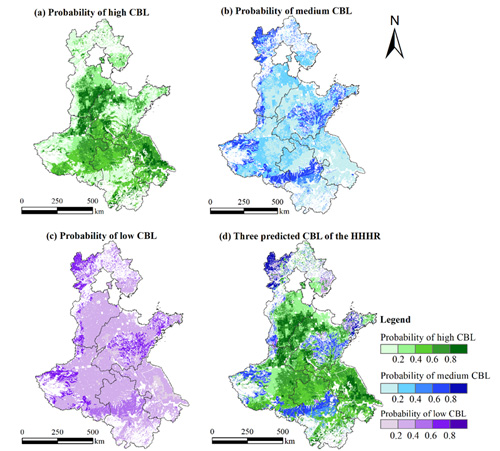Researchers Predict Three Comprehensive Benefit Levels of Well-facilitated Farmland Projects in the Huang-Huai-Hai Region
The establishment of well-facilitated farmland in recent years has played a key role in addressing the issues of land fragmentation and food security in China. The research on comprehensive benefit evaluation and its spatial simulation for well-facilitated farmland projects has great significance to help understanding the benefits of well-facilitated farmland construction and optimize construction design in the future.
Prof. SHI Wenjiao’s team at Institute of Geographic Sciences and Natural Resources Research of Chinese Academy of Sciences provided a detailed analysis of the comprehensive benefits of the construction of well-facilitated farmland projects in the Huang-Huai-Hai Region (HHHR).
The prediction maps of the probabilities of high, medium and low comprehensive benefit levels (CBL) in the HHHR can be used as references for the future planning, design and construction of well-facilitated farmland. This work was published as a cover article in Land Degradation & Development.
The team analyzed the CBL of well-facilitated farmland projects in the HHHR of China during 2011 to 2015 using 568 questionnaires and proposed a method based on a logistic regression model to analyze the CBL-affecting factors and predicted the probability of high, middle and low CBL in each 1 km × 1 km grid.
Under the guidance of Prof. SHI Wenjiao, graduate student WANG Xiaoqing found that there were significant regional and interprovincial differences in the comprehensive benefits evaluation results. The projects with medium and high comprehensive benefits values were mainly located in southern Hebei Province, western Shandong Province and southeastern Henan Province.
The researchers also found that the economic and social benefits of the projects in the plain areas contributed greatly to the increase in the comprehensive benefits of farmland. In contrast, the ecological benefits were greater for the projects in mountainous and hilly areas.
The spatial prediction results indicated that 42.5% (22.5 million ha) of the HHHR, mainly distributed in plain areas, was predicted to have a high CBL with a probability of more than 0.5.
Spatial prediction and simulation of the CBL in the HHHR (Image by Prof. SHI Wenjiao’s group)

Reference: Wang Xiaoqing, Shi Wenjiao*, Sun Xiaofang, Wang Meng. Comprehensive benefits evaluation and its spatial simulation for well-facilitated farmland projects in the Huang-Huai-Hai Region of China. Land Degradation & Development, 2020, 31(14): 1837-1850. DOI: 10.1002/ldr.3566.
Download attachments: